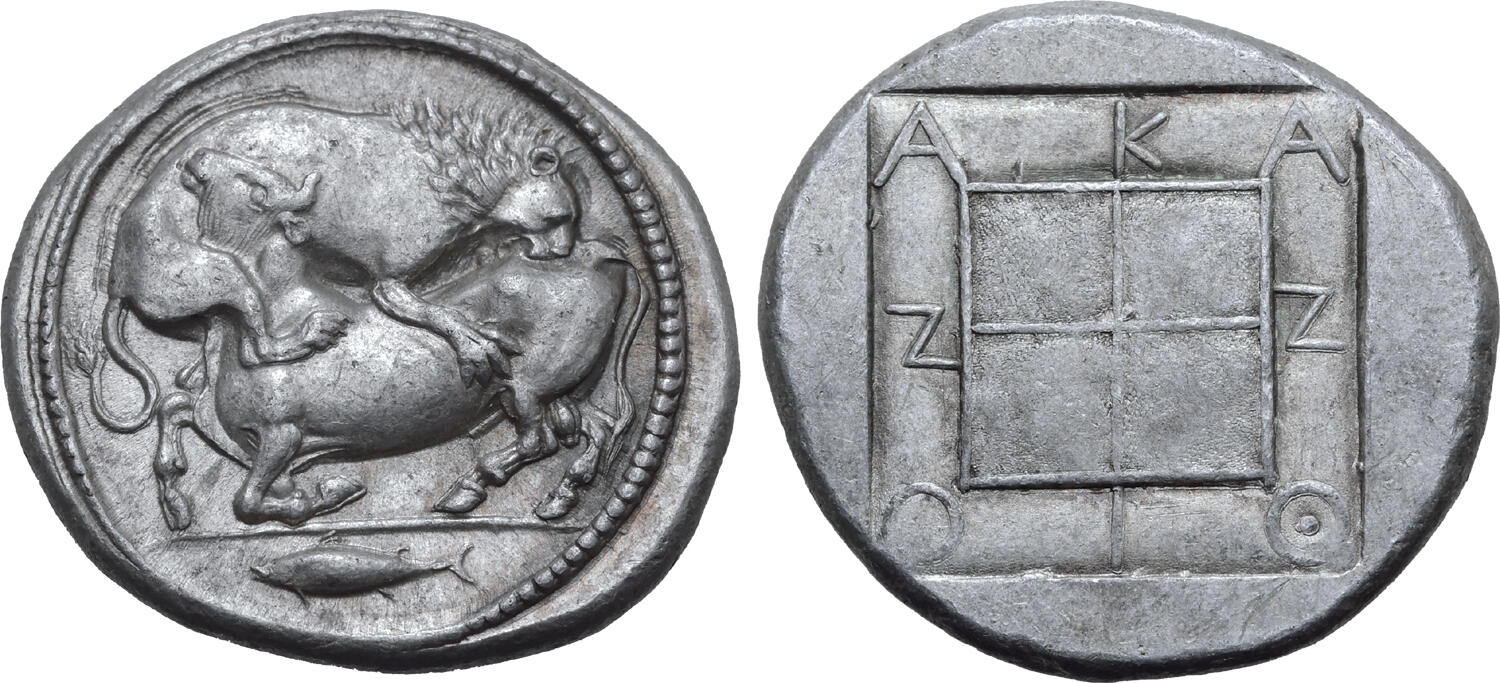480 BCE - 430 BCEϘPO | ϘPO
Overstriking coin
Croton 1382 Spink.jpg
[1]
Overstruck variety
Acanthus bull lion 470 BCE.jpeg
[2]
| Museum collectionMuseum collection:
|
Florence, Museo Archeologico Nazionale
|
Sale(s)Sale(s) ᵖ:
|
Spink, 5014, 28 sept. 2005, 17
|
|
|
|
Description
| ObverseInscription or printing placed on the obverse.:
|
ϘPO (Greek) Tripod. In right field, marsh-bird standing left. Decorated border.
|
ReverseInscription or printing placed on the reverse.:
|
ϘPO (Greek) Tripod. Hatching border (incuse)
|
Mint and issuing power
| MintIdentifies the place of manufacture or issue of a numismatic object.:
|
Croton
|
Ancient regionAncient region.
|
Bruttium
|
Modern countryModern country: Italy
|
AuthorityIdentifies the issuing power. The authority can be "pretended" when the name or the portrait of X is on the coin but he/she was not the issuing power. It can also be "uncertain" when there is no mention of X on the coin but he/she was the issuing power according to the historical sources:
|
|
Chronology
| FromIdentifies the initial date in a range assigned in a numismatic context. 480 BCE toIdentifies the final date in a range assigned in a numismatic context.. 430 BCE
|
Classical 480-323 BC  periodTime period of the numismatic object. periodTime period of the numismatic object.
|
Physical description
MetalThe physical material (usually metal) from which an object is made.: Silver 
|
WeightWeight of the numismatic object (in grams). in grams: 8.018.01 g <br />8,010 mg <br />
|
DenominationTerm indicating the value of a numismatic object. Examples: tetradrachm, chalkous, denarius.: nomos
|
|
|
|
StandardStandard.: Achaian
|
References
| Coin referenceReference of the Coin:
|
Toderi 1973, 4, n° 119, Garraffo 1989, p. 59-67 (p. 60, no. 1a and pl. 71, 2)
|
Coin series referenceReference to coin series study:
|
Toderi 19731Toderi 1973, 4, n° 119, Garraffo 19892Garraffo 1989, p. 59-67 (p. 60, no. 1a and pl. 71, 2), HN Italy3HN Italy, n° 2102, 2104 and 2106, HGC 14HGC 1, n° 1449
|
| Coin series web referenceCoin series web references:
|
|
Description
| ObverseInscription or printing placed on the obverse.:
|
Bull collapsing to left, attacked and mauled by lion upon his back to right
|
ReverseInscription or printing placed on the reverse.:
|
Quadripartite incuse square
|
Mint and issuing power
| MintIdentifies the place of manufacture or issue of a numismatic object. ᵖ:
|
Acanthus
|
Ancient regionAncient region. ᵖ
|
Macedon
|
Modern countryModern country: Greece
|
AuthorityIdentifies the authority in whose name (explicitly or implicitly) a numismatic object was issued. ᵖ:
|
|
Chronology
| FromIdentifies the initial date in a range assigned in a numismatic context. 500 BCE toIdentifies the final date in a range assigned in a numismatic context.. 430 BCE
|
periodTime period of the numismatic object.
|
Physical description
| DenominationTerm indicating the value of a numismatic object. Examples: tetradrachm, chalkous, denarius. ᵖ:
|
didrachm 
|
|
|
References
| Frequency of overstrikesFrequency of overstrikes:
|
rare and concentrated
|
Level of confidenceLevel of confidence of the identification:
|
strong
|
| RemarksRemarks:
|
(visible on obverse: inferior part of circle, posterior part of bull attaked by a lion); (nb: the coin sold by Spink in 2005 is supposed to belong to the MAN in Florence...)
|
References
- ^ Toderi, Guiseppe (1973), Prezzario delle monete coniate in Italia dal 1800 al 1973, Firenze, p. 347.
- ^ Garraffo, Salvatore (1989), "Riconiazioni e cronologie in Magna Grecia", in G. Le Rider et al. (éd.), Kraay-Morkholm essays, Louvain-la-Neuve, p. 59-67, pl. 71.
- ^ Rutter N. Keith et alii (eds.) (2001), Historia Numorum Italy, London, xvi, 223 p., 43 pl.
- ^ Hoover, Oliver D. (2018), The Handbook of Greek Coinage Series, Volume 1. Handbook of Coins of Italy and Magna Graecia, Sixth to First Centuries BC., Lancaster-London, 2018, lxi, 527 pages, 23 cm
- ^ Regling, Kurt (1906), Die griechischen münzen der sammlung Warren, 2 vol., Berlin, G. Reimer, p. 264, pl. 37.

